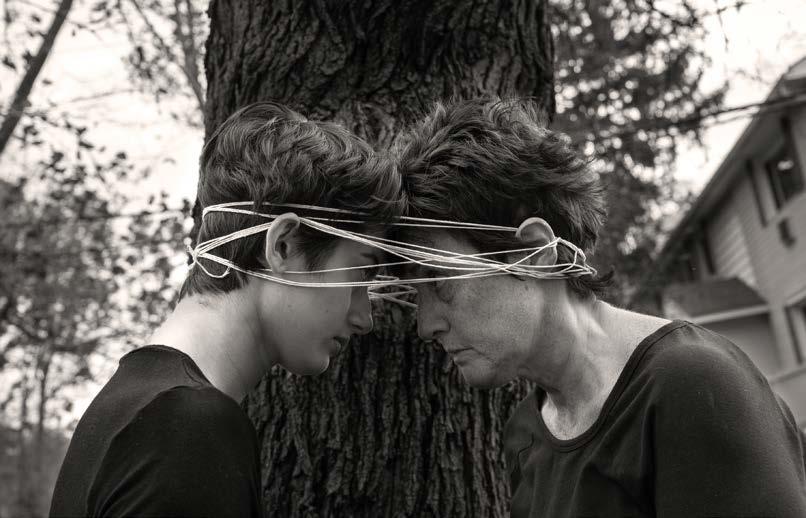
4 minute read
Elisa D’Arrigo (Alumnx
thoughtS From a 1975 alumnx — elisa d’arrigo
What happened once you left school? How has your work changed over time, since your graduation from New Paltz to now?
Since I left school in 1975, a lot has obviously happened, but the constant is I kept making work, and by virtue of that, connecting with art and artists.
In retrospect, I can see that my body of work has built upon things I’ve found so compelling since childhood: drawing, and the magic of creating a line, whether through traditional drawing materials, a hand-sewn stitch, or a clunky cloth-covered wire. The search for form, especially three dimensional form, and how abstract form can communicate meaning and emotion. A love of dance, and how movement and position can be incredibly expressive, and even convey humor.
After graduating in 1975 with a BFA in Ceramics, I moved back to NYC ( I grew up in the Bronx), and continued working in clay until approximately 1981, when I found myself needing a different challenge. I felt drawn to work with materials that were not as responsive as clay, had different properties, or perhaps most importantly, were less familiar to me. That began a decades-long investigation into making sculpture that used or combined materials such as paper, cloth, thread, wire, wax, wood, paper-maché, and unfired clay, all the while incorporating various craft processes in their construction. The resultant abstract forms, which were wrapped, woven, torqued, hand-sewn, or accreted, conveyed the innate psychological qualities of those processes. From the 1990s until 2010, desiring a flexible tactility for my work, I constructed pieces by hand-sewing flat or hollow elements, formed from layers of cloth or paper, and stained with acrylic paint and dry pigments, which imparted an often intense coloration. These densely stitched, undulating forms had no understructure and were held together by thread alone. Seams defined contours; stitches created lines, marks and surface. Each piece unfolded differently depending upon chance and whim. Categories—sculpture, drawing, and painting were dissolved, recalling my work in ceramics, a medium in which these categories are already conflated. This is what first attracted me to ceramics and what intrigues me still. My growing impulse at around this time to introduce humor and a more fluid gesture was uniquely compatible with clay’s immediacy.
Following that impulse, in 2010 I began working with ceramics once again. The vase form, with its necessary orifice, has become my muse. Functionality implies use, whether real or imagined, and suggests an intimate involvement with the viewer, inviting touch, whether real or imagined, and even domesticity.
The pieces begin as hollow, hand-built elements that I manipulate and combine in a period of intense improvisation. The “postures” that result allude to the body in a gestural and even visceral manner. Their hollowness evokes the notion of interiority, and animation from within. Surfaces are activated and even transformed by the alchemical process of glazing.While non-representational, my work alludes to the body from the inside out, and seeks to project a physicality that also embodies states of mind. So I’ve come full circle in a way. One reason I chose SUNY New Paltz was because I heard there was a good ceramics department. I wanted to learn ceramics. I was following my childhood dream to make free-form, wildly patterned ceramic vases. I somehow never quite did that then, but am now.
One of the things we would love to hear from you are your thoughts on what you would say to the young artists that are just graduating now.
I’d say, hang in there, keep working, find ways of keeping on working. Develop relationships with other artists of all disciplines. Look at everything. Be open. The pandemic has shown us (as if we did not already know this), that even a kitchen table can be a studio. Stay excited, follow what is compelling to you.
What role has the community played in your work as an artist?
The community has been almost everything. Source of friendships. Mutual support and encouragement. A reservoir of information and opportunities. The most important audience.
Elisa D’Arrigo
BFA Ceramics, Alumnx 1975
What are the two or three most important things that you suggest to artists to sustain their careers?
For me, the work comes first. Without the work, no career is possible.
1. Show up: that means work in the studio consistently, wherever it is, even if only a sketchbook or a phone app. For me, work begets work, and working creates inspiration. It also means attend the events of other artists/writers/curators: shows, talks, studio visits, performances, readings, presentations.
2. Follow up: apply for things, there are so many opportunities now. Follow up on invitations. Say yes when possible. Stay in touch with contacts you’ve made. Be truly interested in others, and what they are doing.
3. Pay attention in the studio to the unexpected, the unplanned, the “failures”.
4. Wait at least a year before throwing out a piece you think you hate. It may be you’re just not ready for it yet.
Spotificationization 2020. Glazed ceramic, 7 x 5 x 6 in.










